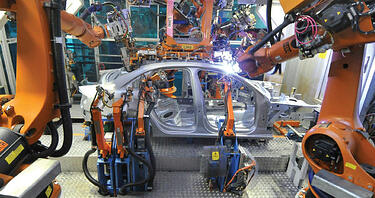Automotive
Today's automotive industry is a complex, high-stakes game depending on global supply chains and just-in-time manufacturing, and subject to financial pressures from every angle. EPM puts manufacturers in the driver's seat for strategic planning, forecasting and budgeting.
 The status quo for many automotive manufacturers and suppliers is a myriad of siloed planning processes that do not integrate to provide a cohesive landscape. This inefficient ecosystem produces disconnects where operational plans are not as dynamic as they need to be for changing demand curves from customers, profitability of products is not well understood, and the result is less than optimal – and often expensive – decisions are made.
The status quo for many automotive manufacturers and suppliers is a myriad of siloed planning processes that do not integrate to provide a cohesive landscape. This inefficient ecosystem produces disconnects where operational plans are not as dynamic as they need to be for changing demand curves from customers, profitability of products is not well understood, and the result is less than optimal – and often expensive – decisions are made.
Our vision for a properly evolved EPM capability starts with an integrated capability across strategic, operational and financial planning. In the automotive industry, we recommend clients start with strategic plans that identify market size, current participation and projected share increase/decrease. Add unit projections by platform and plant purchased from a third party data supplier. These projections can then be leveraged as the basis for rough cut capacity analysis, which yields margin-optimized supply chain purchases and production schedules across your manufacturing plants. From there, we can create financial plans that fund strategic initiatives that are projected to impact such output KPIs as: demand, quality, safety, and cost.
Such a comprehensive capability requires three things: a vision for the value such a sophisticated integrated business planning capability could yield, the technology to create this seamless functionality, and the right partner to guide you along the way. This kind of solution is not something you can purchase off the shelf, or implement in one project. This is a series of step changes to your current technology and processes. Take control of your performance, and move toward this advanced state starting with the next investment in Business Analytics.
Start with Column5's starter kits for rapid time to value, broader functionality and proven usability based on many real world customer's best practice approaches. For the Automotive industry, relevant starter kits include:
S&OP: Integrate demand forecasts coming from manager input, historical actuals or purchased third party forecast data. Align demand with production schedules and optimize inventory levels to maximize capital allocation.
Capex: Changing customer demands require new plants, retooling, and other big ticket investments to be made. Instead of allocating capital resources based on a "last year’s capital spend +/- x%" mode, align capital investments to strategic business initiatives for accelerated achievement of goals
HCM: Managing the cost of human capital is critical for all businesses, but for those with long term commitments to benefits and other costs, detailed visibility is key. Manage these costs on an integrated platform so you know when and where you will need employees to achieve objectives.
Integrated Detail: EPM solutions alone do not provide enough detail reporting capabilities to meet every level of analysis. Instead, use BI integrated with your EPM solution to provide seamless analysis with clicks instead of "swivel chair integration" - turning from one system to another with the user providing similar filtering to compare data from your EPM system to your DW, or ERP system.
SharePoint Integration: When coordinating the efforts of many people - into the hundreds - the greater the guided experience, the easier the system is to use. Incorporate supporting documents, calendars, blogs, and other collaborative components not found when using EPM solutions on their own.




